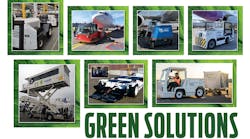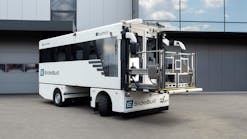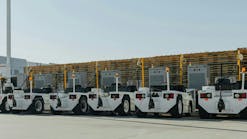Waev Inc. has recently introduced lithium-powered tow tractors that meet payload requirements of all-day duty cycles to assist airports in meeting demands to cut carbon emissions. The company’s Li-Ion Tiger and Bigfoot lines do not produce emissions, require minimal maintenance and utilize common parts to ease the transition to a lithium-ion fleet.
“And the infrastructure requirements can scale with the fleet, as required, starting with as little as dedicated 110v-240v single phase outlets up to 480v fast charging options,” says Gerry Hoadley, director of ground support equipment at Waev. “This makes the transition much easier and allows it to be done in phases.”
The Li-ion Tiger is a conventional baggage/cargo tractor has a towing capacity of up to 60,000 pounds and can be equipped with a 36kWh or 48kWh power module. The tractors can be charged using Waev’s standard on-board 6.6kW charger or it can be equipped for 480v fast charging. For smaller operations that require less capacity, the Bigfoot XL burden carrier can tow 10,000 lbs and can be equipped with an array of battery options.
“We use only LiFePO4 cells in our lithium power modules which is known to be one of the most stable chemistries in the battery industry,” Hoadley says. “At the end of the serviceable life of our power modules, the cells can be utilized for energy storage in things such as power walls and off-grid power sources.”
Most serviceable components used in the Tiger tractors are based on industry standards, so service parts from existing fleets can often be used. The modular chassis eases the maintenance transition too. The chassis can accommodate battery packs or internal combustion engines (ICE). Then if a customer wants to convert a diesel-powered tractor to battery power, the chassis easily allows it.
“We’re developing the repower packages now to provide customers with everything needed to upgrade legacy ICE powered tractor fleets,” Hoadley says.
What’s more, the Li-Ion Tiger’s anti-rollover system automatically slows to a safe speed when a driver enters a turn too aggressively, mitigating the chances of a roll-over.
According to Hoadley, customer feedback about the new tractors have been positive and more airlines and ground handlers are turning to lithium-ion battery technology. He suggests that anyone interested in using Li-ion-powered equipment do their homework and better understand how their fleet can utilize the technology.
“We need to do a better job of informing fleet managers about all considerations of electrification,” Hoadley says. “Yes, you will you have to train and remind operators to plug in the tractors, but you can opportunity charge – or top-off – without causing damage to the battery, something non-Lithium batteries struggle with.
“You can charge on a dedicated, single-phase outlet (110v to 240v), but you can charge quicker with infrastructure upgrades like 480v fast smart chargers,” he adds.







